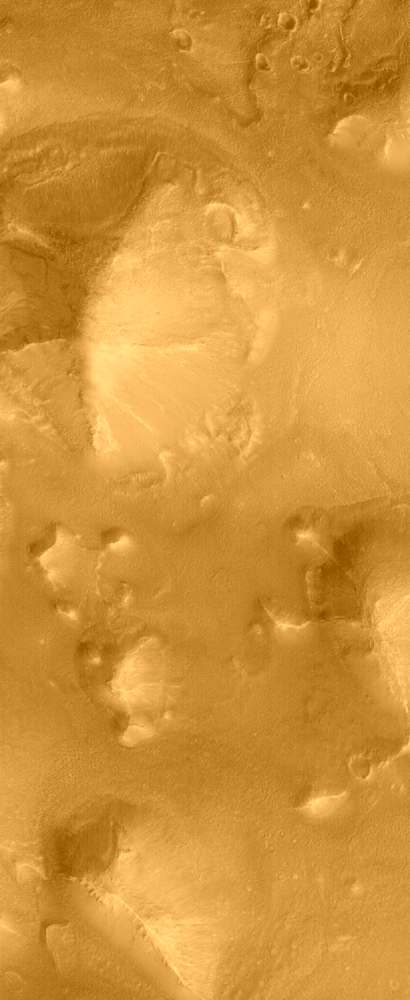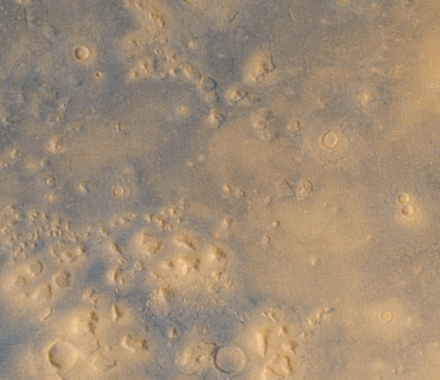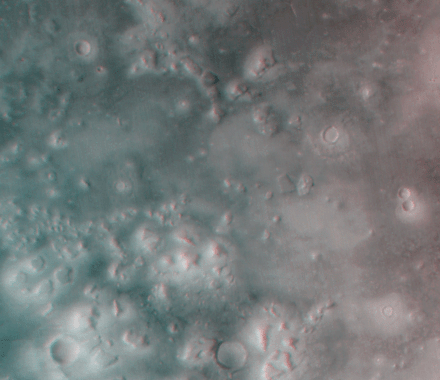|
| |||||
|
The Investigation
Esteemed Scientists Uncover the Truth
Despite the ramifications and enormous historic importance
authorities have constructed a "Laughter Curtain" around the Face. But many scientists have now gone on to pursue the truth on their own. Scientists have developed new techniques to determine if they were, in fact, natural formations,
and the Face is now proven to be "Non Fractal" ~ therefore indisputably unnatural by any standard. The odds that the Face on Mars could be a natural formation are calculated to be many billions to one, while all other "tricks of light and shadow" go completely unnoticed by the computer's fractal analysis. These same techniques have since been adopted and used extensively by the US Military Intelligence to make out countless camouflaged terrorist and other enemy installations, from satellites in space. Why, when evidence points to artificial features on another planet, is it casually dismissed ?
| ||||||
|
Light and Shadow
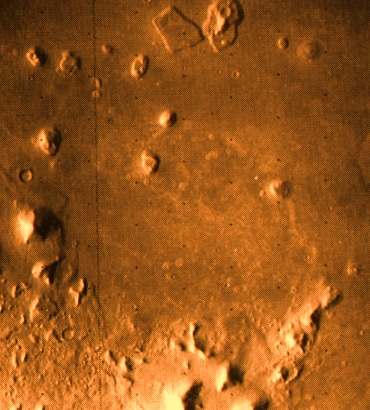
On July 25, 1976, when the frame 35A72, the original image of the Face on Mars, was discovered by Viking engineers, their hearts stopped.
After they collected themselves, like most of us would, they made sure it was to be the first order of the day,
(even if it turns out to be an optical illusion, this is something very interesting and one of the things that we scientists plan to be spending a lot of time and effort on).
Thus, much like Roswell, some thirty years earlier, the press got wind of it before officials could stop it.
A photo already having been released, along with the expected speculation, JPL then made a somewhat successful last ditch attempt at spin control: "The picture shows eroded mesa-like landforms. The huge rock formation ... which resembles a human head, is formed by shadows giving the illusions of eyes, nose, and a mouth." As if it never entered their minds for a minute that the objects in question could possibly be artificial, an official spokesman for JPL also said in a press conference that day, that a "later image" of the site showed the formation to be merely "a trick of light and shadow" - and the story ended up being no more than somewhat interesting fluff, a lighter sidebar to contrast the "hard science" in NASA's latest triumph, and only a slight distraction away from all the hard data received by Man's first mission to Mars. |
|
New Attention
Only a small number of the Viking aerial images were decoded from the raw data into pictures - and even fewer were made public.
The rest were supposedly filed away for future reference, and mostly forgotten about - until 1977, a year after the image was received,
when frame 35A72 was rediscovered by two engineers at the Goddard Spaceflight Center, Vincent DiPietro (below left) and Gregory Molenaar.
Until that very moment, these gentlemen were considered highly esteemed NASA scientists,
and are today among the main figureheads in the serious, if rogue, scientific investigation of the Cydonia complex.
They had not heard the story of the Face on Mars - practically no one had, or it had been long forgotten.
But they were under the impression that they would be taken seriously, if their methods were sound, no matter what their conclusions.
Besides, it seemed somewhat important. They were in for the ride of their lives.
In 1979, lacking any further evidence one way or another, as high resolutions of the surface were another two decades off, DiPietro and Molenaar - specialists in the fields of computer image analysis on contract to NASA - working on their own, and in secret, developed the Starburst Pixel Interleaving Technique (or SPIT, for short, as in "spitting image"). The image of the face from the Viking frame was a mere 64 pixels square. Basically what they did was divide each pixel into nine subsections, and program their computer to glean the true shade from the data collected about its neighbors. They put both images "through the spitter." What they found was not that the appearance of a face was a chance coincidence or optical illusion, but that it looked even more like a face, bringing out even more startling details. Even this new evidence was scoffed or ignored by their superiors and colleagues at NASA. It seemed like no matter what proof they came up with, the science was falling on deaf ears. In 1980, after three long years of futility and frustration through proper NASA channels, they took their message to the people and published their findings in their book "Unusual Mars Surface Features" with physicist John Brandenburg - and later presented their work at the 156th meeting of the American Astronomical Society. Going public brought the seriousness of the issue to the attention of many potential allies in the struggle for truth - among them, science writer Richard Hoagland, at the first Case for Mars Conference in July of 1981, who was himself present at the original output of NASA disinformation on the Viking 1 face frame in 1976. Hoagland, after viewing further image enhancements of the region, two years later in 1983, would go on to discover other interesting features, dubbed "The City" and "The Fortress" - which are now considered to be among the more important monuments in the immediate vicinity of The Face. He also determined that the City, Face and Cliff appear to be aligned with the Martian summer solstice of Cydonia several hundred thousand years ago!
Note: This unofficial dating of the unofficially archaeological Martian site
fits in with some theories of ancient civilizations, such as Atlantis and Lemuria: that humans arrived in this star system eons ago, settling on the inner planets, but suffered many cataclysms ~ their great society passing into mythology. Official groups were formed to look into the matter further, such as the Independent Mars Investigation, the IMI - and MIG, the Mars Investigation Group - but wherever possible, funding was eventually cut due to the controversial nature of their findings and their general refusal to let the issue be quietly swept under the rug. Many of the individuals involved have suffered serious personal, professional, and even physical hardships because of their interest in these strange geographical anomalies, obviously artificial in nature, on the surface of another planet - the ramifications of which would completely rewrite history, and call into question much of what we consider to be status quo, not the least of which being: the dismissal of scientific evidence, and the people who discover them, based on mere political convenience.
|
| From: Face and Nearby Objects on Mars by Mark Carlotto | |
|
|
The Face on Mars, as shown in the original 1976 Viking images 35A72 (left) and 70A13 (right),
with the originals, restored by Mark J. Carlotto (top) and corresponding colorized versions (below).
It is easier for the Human eye to make out fine details in shades of red, rather than in shades of gray.
35A72 was the original image, that made a brief ridiculed media ripple the day the image was received,
rediscovered years later by Goddard Spaceflight Center engineers Vincent DiPietro and Gregory Molenaar.
70A13, shows even more detail, the sun being at about a 20� higher angle, taken earlier on a later afternoon.
If this is the "later image" that showed the Face to be "just a trick of light and shadow," it seems a better trick.
| From: The Case for the Face - by McDaniel, Paxon, et al - p. 283-286 | |
|
|
Image Enhancement  The original Viking images were transmitted as mathematical data, between absolute light and dark on the 256 grayscale
- with each pixel assigned a value based on an average tone for an area of approximately 50 square meters, as seen from an altitude of about 1800 kilometers.
Therefore, only very large objects, of at least twenty five feet in width, can possibly stand out as the smallest speck.
This was considered to be sufficient for the purposes of the mission then
- which was to gain a better understanding of Martian topography in general, and also find a suitable landing site for Viking 2.
The original Viking images were transmitted as mathematical data, between absolute light and dark on the 256 grayscale
- with each pixel assigned a value based on an average tone for an area of approximately 50 square meters, as seen from an altitude of about 1800 kilometers.
Therefore, only very large objects, of at least twenty five feet in width, can possibly stand out as the smallest speck.
This was considered to be sufficient for the purposes of the mission then
- which was to gain a better understanding of Martian topography in general, and also find a suitable landing site for Viking 2.
This famous and highly controversial three dimensional image of Cydonia (right) was generated by computer scientist and Cydonia investigator Mark J. Carlotto PhD, using the "Shape from Shading" extrapolation technique he developed for the project. Here, Cydonia is tilted to scale for a high southwesterly view, using perspective data interpreted from image analysis, and shaded a dark Martian orange to make the three dimensional effect more obvious. Because this is technically an artificial image, the obvious artificial nature of the objects shown here has been called into question, but mostly ignored by mainstream science - although this technique has been proven successful on terrestrial objects, and is often utilized for other purposes. To give you something of an idea as to their immense size, the faded crater in the center is approximately two miles in diameter - the City and Fortress (lower left) are more than ten miles away from the Face (upper right), as is the D&M Pyramid (lower right), named for its discoverers, DiPietro and Molenaar. These are massive objects - on an otherwise relatively flat plain, and obviously arranged in some intelligent pattern, reminiscent of the great pyramids in Egypt and Mexico. Also like many ancient pyramid sites on Earth, it was constructed near an ocean shoreline - and if you were on the surface of Mars, they would be visible from many miles away. As conspicuous as a modern city skyline, or the giant towering mesas of the American Southwest, an observer on Mars approaching Cydonia would feel very small by comparison. Even before rigid conservative tests were performed on the features, it is clear that no known pattern of wind erosion can possibly account for the stark geometric shapes jutting out of the flat Martian terrain. The Face proved to be even more artificial by fractal analysis than control photographs of the Pentagon, an international airport, and a military base with straight roads and many orderly rows of rectangular buildings. When the requirements were turned up well beyond the realm of any possible speculation, the mound still showed up a very light blurry blip on the screen, amid a now completely darkened background. Innumerable tests were performed on the original and subsequent interpolated photographs - and tests upon the tests, and tests upon the test results. Horace Crater, physics professor at the University of Tennessee Space Institute and President of the Society for Planetary SETI Research (SPSR), has this to say about the painstaking investigation Cydonia: "The striking thing about these tests is that not a single one has turned up negative results. Instead of weakening the hypothesis, the tests, one by one, added to the probability that The Face may be an ET artifact." |
|
Malin Space Science Systems composite of multiple Viking frames
allows a more wide angle perspective of the entire Cydonia region.
|
Deliberate Sabotage
In the years prior to the historic Pathfinder and Surveyor missions, there was a mass public outcry demanding further examination and public disclosure of the Cydonia site.
But, as if on cue, just the night before Hoagland was scheduled to debate the issue on live national TV, yet another highly anticipated mission mysteriously failed.
Suspicious timing, the event temporarily distracted the attention of an otherwise Cydonia primed public
- and succeeded in preventing new information from being broadcast on national television.
On August 21 1993, Mars Observer met the same fate as other probes to the red planet, like the Russian Phobos II: all contact was permanently lost - for reasons unknown or yet to be determined. The mission promised much higher resolution photos (fifty times greater than Viking images), that could have blown the lid off of the Cydonian mystery. The NASA story goes: that contact was purposely "temporarily" cut off at mission control (for dubious reasons), but was never regained. Official technical explanations are weak or vague at best, and most serious investigators claim to hold no conspiracy theories, at least publicly. But many scientists, including Hoagland, openly accuse that Mars Observer is actually alive and well - and that NASA maintains clandestine contact, with more of a mission than most imagine possible. If this were true, NASA had to act as if Observer had failed, and use none of that data openly for the upcoming Pathfinder mission. Thus, kudos all around for NASA and JPL, when evidence of great quantities water was discovered to have been on the surface of Mars long ago. These conspiracy theories go on to surmise that there are many missions to Mars, and other bodies within the solar system, that are completely unknown to the public. These missions must remain top secret, mainly because of the nature of their discoveries, but also because of the high-tech power sources involved. If the greater "powers that be" were to reveal to their lesser neighbors, the "powers that want to be" that the technology exists to indefinitely put a spacecraft in orbit around virtually any planet in the solar system, our world would soon become one that we may not be entirely ready for - or certain political entities don't want us to be. Ufologists speculate that this supposed technology is not without merit, even by more primitive Cold War standards - and that a combination of nuclear and solar power could possibly, even easily, have been implemented as early as the mid 1950s. Similar theories have been put forward as to Lunar expeditions, and even Lunar anomalies - more ancient extraterrestrial monuments, covered up by NASA. The far side of the moon would be a perfect place for such operations, completely hidden from view of the planet Earth. Radio communication would also be perpetually blocked - the perfect location for a secret base. But perhaps one of the best kept secrets in technological government endeavors is how relatively inexpensive operations of these types are to realize, once all resources are completely internalized - if only it were more believable.
The whiff of conspiracy surrounding American space exploration is not confined to the present day. NASA's Apollo Seal (left), with the A depicted as crossed by Orion's Belt (among other subtleties), some speculate is a direct reference to the Giza Pyramids, which are arranged and align exactly with the constellation - tying into a vast conspiracy involving world governments and secret societies, that date back even to the Age of the Pyramids. In an obscure federal law, it is illegal for anyone to come into contact with extraterrestrial beings or artifacts - punishable by a $5000 fine and up to a year in jail. The Administrator of NASA, Dan Goldin, has ultimate authority in such cases. In any case, on the American Independence Day, July 4, 1997, the highly celebrated Mars Pathfinder landed at Ares Vallis (Mars Valley) - almost 50 years to the day after the Roswell incident (perhaps only coincidentally) - and naturally diffusing much attention from there, as the centerpiece of a very big week for space enthusiasts. Millions watched worldwide as the Sojourner Rover rolled out onto the surface, after the probe parachuted in and bounced to a near perfect landing. Much was made of the tiny robot, operated by remote control millions of miles away - and rocks that showed signs of ancient oceans. But many suggest that the sheer celebrity of events like this, including the Mars Rock finding, were purposely blown way out of proportion - and even partially designed to distract public attention away from the Cydonia issue.
|
|
High resolution images of the Face, made from the original 1998 MGS image.
False color added (left), and inverted to simulate lighting from the northwest (right).
Click here to see the larger original full-size, black and white version (72K).
| From:
Cydonia: Two Years Later
MGS Status Report - February 23, 2000 | |
|
|
|
A Rock and a Hard Place
Also considered a convenient distraction to the Cydonia anomalies: the much celebrated Mars Rock, ALH84001 (below right)
that appears to contain microfossils of ancient Martian bacteria (below right)
- the timing of which was meant to overshadow the landmark work of
Vincent DiPietro and Dr. John E. Brandenburg, supporting the Cydonian evidence.
Over a decade of painstaking research, involving many different branches of science,
came to an abrupt and anti-climactic halt when NASA made their historic announcement:
that it was found December 27, 1984 by Roberta Score of the National Science Foundation on an expedition to the Alan Hills region of Antarctica,
was immediately shipped off to NASA archaeologists, where it was supposedly ignored for nearly a decade.
These mavericks of science, who don't have any problem with the idea that life once existed on Mars, and may still even today, had been working since 1984 on a way to get the Cydonian issues finally and publicly accepted by mainstream science. Knowing first hand and from similar experience that many of their colleagues were afraid to publish similar findings along these lines, their new "guerrilla science" tactics involved "preemptive strikes" - paving the way for more controversial conclusions to be more readily accepted - in fact, completely irrefutable.
|
|
MGS high resolution close up of the City (above)
MGS wide angle image in color, and 3D (below)
|
|
| The Face on Mars | ||
|
The Viking Photos
� The Investigation
The Face � Pyramid Cities � Disaster
| ||
|

 After becoming somewhat educated in the saga that was Cydonia, and sometimes first hand, a search for any supposedly more revealing photos proved fruitless.
But they did discover another perhaps more interesting snapshot of the region, frame 70A13 (above), the only other known Viking image of the Face on Mars.
It was taken roughly 35 orbits after 35A72, at a higher sun angle, and shows even more convincing details of the Face.
After becoming somewhat educated in the saga that was Cydonia, and sometimes first hand, a search for any supposedly more revealing photos proved fruitless.
But they did discover another perhaps more interesting snapshot of the region, frame 70A13 (above), the only other known Viking image of the Face on Mars.
It was taken roughly 35 orbits after 35A72, at a higher sun angle, and shows even more convincing details of the Face.
 Since then, many more learned individuals from all relevant realms of science have dared to investigate
what little information there is available about the site, and concluded that Cydonia merits at least further study.
In their research, they came across scores of colleagues who were making many interesting discoveries along the same lines.
Among the few who are not afraid to release their findings because of the seriousness of their implications is computer scientist Mark J. Carlotto PhD,
who published "The Martian Enigmas" in 1991, and is perhaps most famous for his "Shape From Shading" technique
(different from that of DiPietro and Molenaar) in which his landmark three dimensional renderings of Cydonia were developed.
Image processing engineer Ananda Sirisena wrote an article for the British professional magazine Image Processing, entitled "Intelligent Faces on Mars?" in 1992.
A Secondary Face, a four sided pyramid, three curious mounds arranged in a right triangle
- and a curious feature known as the Sirisena Quadrangle, featuring a cave and what resembles a jetty or harbor
are among his discoveries, in an area just northwest of the Cydonia Complex, as shown in Viking frames 70A11 and 561A25.
In 1993, Stanley McDaniel (above right), releases a scientific paper on the subject, "The McDaniel Report"
- subtitled: "The failure of executive, congressional and scientific responsibility in investigating possible evidence
of artificial structures on the surface of Mars, and in setting priorities for NASA's Mars exploration program."
Since then, many more learned individuals from all relevant realms of science have dared to investigate
what little information there is available about the site, and concluded that Cydonia merits at least further study.
In their research, they came across scores of colleagues who were making many interesting discoveries along the same lines.
Among the few who are not afraid to release their findings because of the seriousness of their implications is computer scientist Mark J. Carlotto PhD,
who published "The Martian Enigmas" in 1991, and is perhaps most famous for his "Shape From Shading" technique
(different from that of DiPietro and Molenaar) in which his landmark three dimensional renderings of Cydonia were developed.
Image processing engineer Ananda Sirisena wrote an article for the British professional magazine Image Processing, entitled "Intelligent Faces on Mars?" in 1992.
A Secondary Face, a four sided pyramid, three curious mounds arranged in a right triangle
- and a curious feature known as the Sirisena Quadrangle, featuring a cave and what resembles a jetty or harbor
are among his discoveries, in an area just northwest of the Cydonia Complex, as shown in Viking frames 70A11 and 561A25.
In 1993, Stanley McDaniel (above right), releases a scientific paper on the subject, "The McDaniel Report"
- subtitled: "The failure of executive, congressional and scientific responsibility in investigating possible evidence
of artificial structures on the surface of Mars, and in setting priorities for NASA's Mars exploration program."

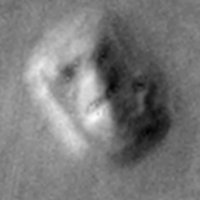
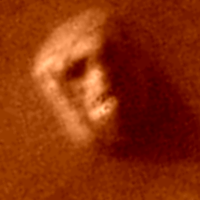
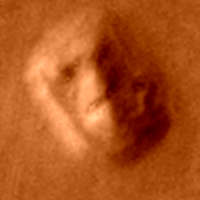
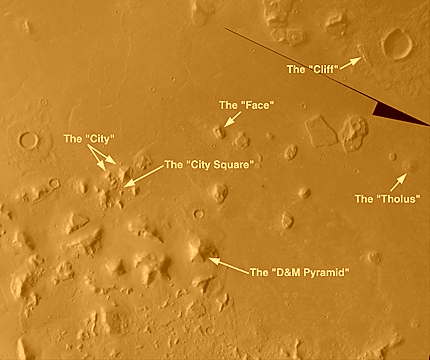
 Just before NASA's new mass Mars mapping projects began taking a turn more towards the ill-fated, Daniel Goldin, a former "Cold Warrior"
was made head of NASA by then President George Bush, former head of the CIA - after spending twenty five years at TRW, a top secret defense contractor.
An ominous force at the new NASA (more covert, less kinder and gentler), and the only federal agency head not replaced under the Clinton administration.
In his public statements, he seems more like a politician than a scientific administrator, genuinely curious about anything in outer space
- and his message: keeping NASA at the forefront of any future space exploration endeavors.
Just before NASA's new mass Mars mapping projects began taking a turn more towards the ill-fated, Daniel Goldin, a former "Cold Warrior"
was made head of NASA by then President George Bush, former head of the CIA - after spending twenty five years at TRW, a top secret defense contractor.
An ominous force at the new NASA (more covert, less kinder and gentler), and the only federal agency head not replaced under the Clinton administration.
In his public statements, he seems more like a politician than a scientific administrator, genuinely curious about anything in outer space
- and his message: keeping NASA at the forefront of any future space exploration endeavors.
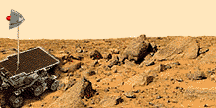 Once every rock on the horizon was given a cute name, and the rover ran out of battery power, the public's attention eventually drifted away from all things Martian.
Stories about the Face that made the news concentrated primarily on NASA's distorted images that don't happen to look anything like a face.
Claims by image processing experts that the pictures were distorted, to make it look most like a deformed outcropping, are totally ignored.
Once every rock on the horizon was given a cute name, and the rover ran out of battery power, the public's attention eventually drifted away from all things Martian.
Stories about the Face that made the news concentrated primarily on NASA's distorted images that don't happen to look anything like a face.
Claims by image processing experts that the pictures were distorted, to make it look most like a deformed outcropping, are totally ignored.
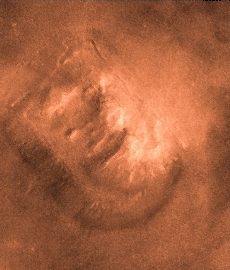

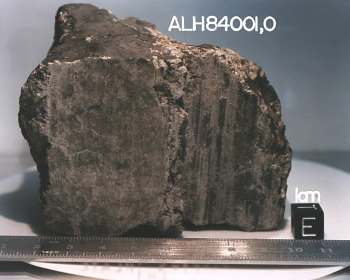 Until August of 1997, science had long held that Mars is a barren wasteland, incapable of supporting any kind of life.
When pressed, officials would grudgingly admit somewhat "unofficially" that the jury was still out.
The reality is, there is all kinds of evidence supporting the existence of microbial life, and therefore water, on Mars
- and NASA has known this for years, but for some reason didn't want it to become common knowledge.
They only eventually made public this "discovery" of microfossils in Martian meteorites (below left) when it was being investigated by other scientists
who were intending to actually use the information in further support of their substantiated but controversial theory that life once flourished on Mars
- and thus discrediting any rebuttal by mainstream science that there could not possibly be a Face on Mars
- or pyramids, or anything else artificial for that matter
- much less anything obviously constructed by human beings several hundred thousand years ago.
Until August of 1997, science had long held that Mars is a barren wasteland, incapable of supporting any kind of life.
When pressed, officials would grudgingly admit somewhat "unofficially" that the jury was still out.
The reality is, there is all kinds of evidence supporting the existence of microbial life, and therefore water, on Mars
- and NASA has known this for years, but for some reason didn't want it to become common knowledge.
They only eventually made public this "discovery" of microfossils in Martian meteorites (below left) when it was being investigated by other scientists
who were intending to actually use the information in further support of their substantiated but controversial theory that life once flourished on Mars
- and thus discrediting any rebuttal by mainstream science that there could not possibly be a Face on Mars
- or pyramids, or anything else artificial for that matter
- much less anything obviously constructed by human beings several hundred thousand years ago.
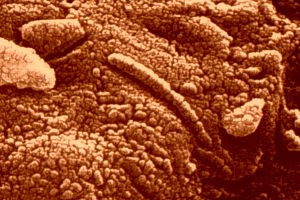 They were very busy building up solid evidence in geology and microbiology, for years, to later back up their facts regarding planetary science.
They first had to prove that certain rocks did in fact contain microfossils, and then that these rocks did in fact originate from Mars.
Still on contract to NASA at Goddard, DiPietro hopefully (and perhaps naively, considering NASA's stance on Martian matters)
showed some of their findings to Goldin in 1995, who at the time seemed only vaguely interested.
The few pictures and summary conversation were enough for Goldin to know what they had been up to, with their collective side projects.
Knowing their ties to the Cydonian cause, Goldin realized they were about to prove their case and decided to preempt the preemptors.
NASA had the rocks and knew what they were, and the implications thereof - but until now had no reason to make them public.
Brandenburg and DiPietro were just about to release their indisputable findings of microfossils in known Martian meteorites
- and thus further their case for serious study of Cydonia, when the story of the Mars Rock hit the news.
At the press conference, Goldin drove home a final nail when he made the expressed point of emphasizing:
"There is no evidence or suggestion that any higher life form ever existed on Mars."
From this point on, any Cydonian investigator pointing to microbial data looks like they're grasping at straws
and latching on to any new legitimate scientific discovery to seem more credible.
They were very busy building up solid evidence in geology and microbiology, for years, to later back up their facts regarding planetary science.
They first had to prove that certain rocks did in fact contain microfossils, and then that these rocks did in fact originate from Mars.
Still on contract to NASA at Goddard, DiPietro hopefully (and perhaps naively, considering NASA's stance on Martian matters)
showed some of their findings to Goldin in 1995, who at the time seemed only vaguely interested.
The few pictures and summary conversation were enough for Goldin to know what they had been up to, with their collective side projects.
Knowing their ties to the Cydonian cause, Goldin realized they were about to prove their case and decided to preempt the preemptors.
NASA had the rocks and knew what they were, and the implications thereof - but until now had no reason to make them public.
Brandenburg and DiPietro were just about to release their indisputable findings of microfossils in known Martian meteorites
- and thus further their case for serious study of Cydonia, when the story of the Mars Rock hit the news.
At the press conference, Goldin drove home a final nail when he made the expressed point of emphasizing:
"There is no evidence or suggestion that any higher life form ever existed on Mars."
From this point on, any Cydonian investigator pointing to microbial data looks like they're grasping at straws
and latching on to any new legitimate scientific discovery to seem more credible.
